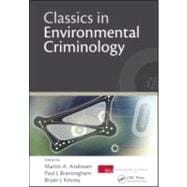
Note: Supplemental materials are not guaranteed with Rental or Used book purchases.
Purchase Benefits
Looking to rent a book? Rent Classics in Environmental Criminology [ISBN: 9781439817797] for the semester, quarter, and short term or search our site for other textbooks by Andresen; Martin A.. Renting a textbook can save you up to 90% from the cost of buying.
| Acknowledgments | p. v |
| A Note on the Texts | p. vii |
| Permissions | p. ix |
| About the Editors | p. xi |
| Early work on the Ecology of Crime | |
| The Place of Environmental Criminology within Criminological Thought | p. 5 |
| Of the Development of the Propensity to Crime (1842) | p. 29 |
| Localities of crime in Suffolk (1856) | p. 77 |
| Juvenile Delinquency in a Small City (1916) | p. 83 |
| Juvenile Delinquency and Urban Areas: A Study of Rates of Delinquency in Relation to Differential Characteristics of Local Communities in American Cities (1969) | p. 87 |
| Urban Ecological Aspects of Crime in Akron (1974) | p. 125 |
| Intraurban Crime Patterns (1974) | p. 155 |
| Classics in Environmental Criminology | |
| Social Change and Crime Rate Trends: A Routine Activity Approach (1979) | p. 187 |
| Routine Activities and Crime: An Analysis of Victimization in Canada (1990) | p. 217 |
| Notes on the Geometry of Crime (1981) | p. 231 |
| The Use of Space in Burglary (1985) | p. 257 |
| Nodes, Paths, and Edges: Considerations on the Complexity of Crime and the Physical Environment (1993) | p. 273 |
| Modeling Offenders' Decisions: A Framework for Research and Policy (1985) | p. 311 |
| Linking Criminal Choices, Routine Activities, Informal Control, and Criminal Outcomes (1986) | p. 341 |
| Understanding Crime Displacement: An Application of Rational Choice Theory (1987) | p. 351 |
| Environment, Routine, and Situation: Toward a Pattern Theory of Crime (1993) | p. 365 |
| Environmental Criminology and Crime Prevention | |
| A Conceptual Model of Crime Prevention (1976) | p. 395 |
| Crime Prevention and Control through Environmental Engineering (1969) | p. 409 |
| Criminal Behavior and the Physical Environment: A Perspective | p. 431 |
| Situational Crime Prevention: Theory and Practice | p. 449 |
| Routine Activities and Crime Prevention in the Developing Metropolis (1987) | p. 461 |
| Future Spaces: Classics in Environmental Criminology-Where Do We Go from Here? | p. 481 |
| References | p. 489 |
| Index | p. 527 |
| Table of Contents provided by Ingram. All Rights Reserved. |
The New copy of this book will include any supplemental materials advertised. Please check the title of the book to determine if it should include any access cards, study guides, lab manuals, CDs, etc.
The Used, Rental and eBook copies of this book are not guaranteed to include any supplemental materials. Typically, only the book itself is included. This is true even if the title states it includes any access cards, study guides, lab manuals, CDs, etc.